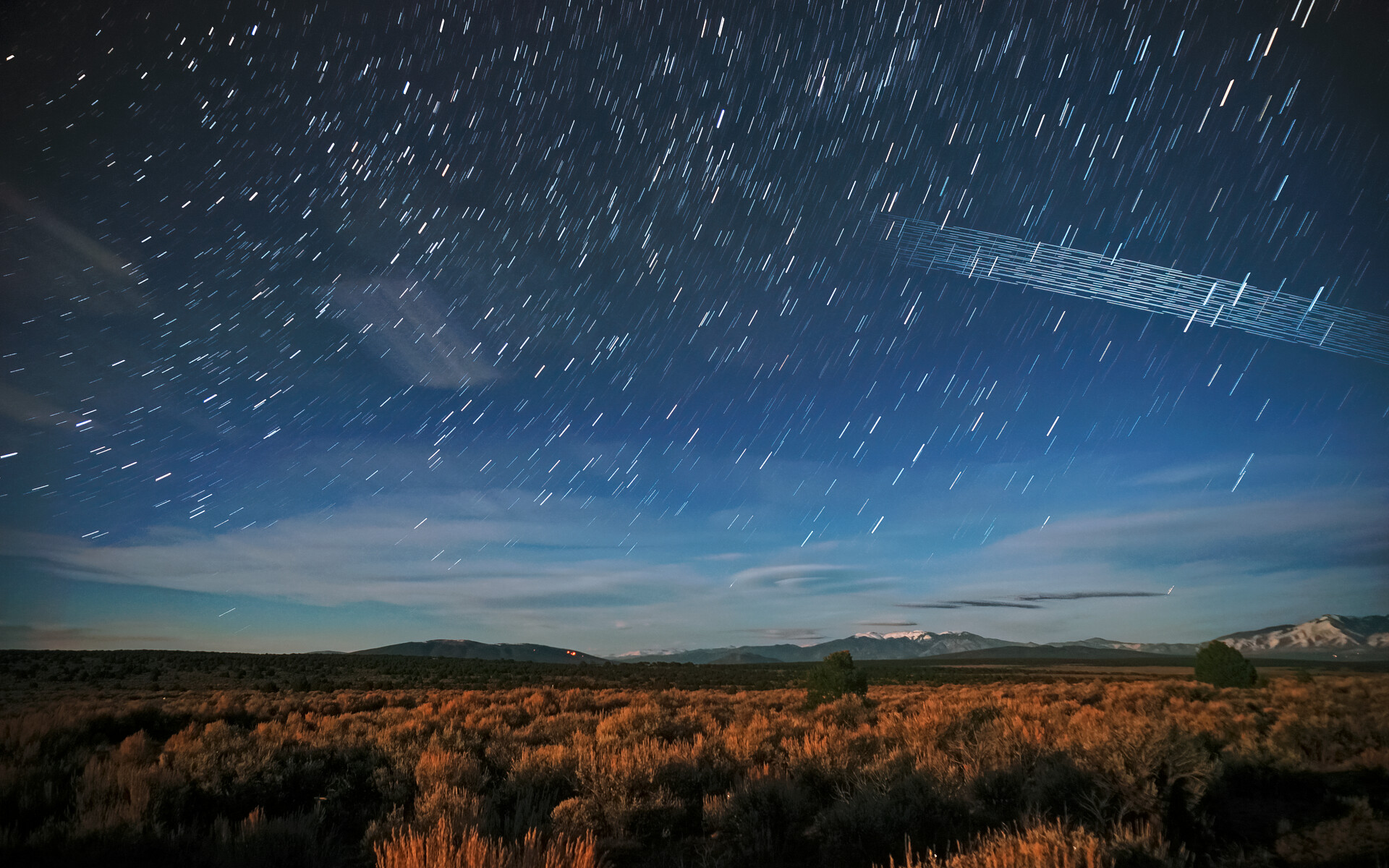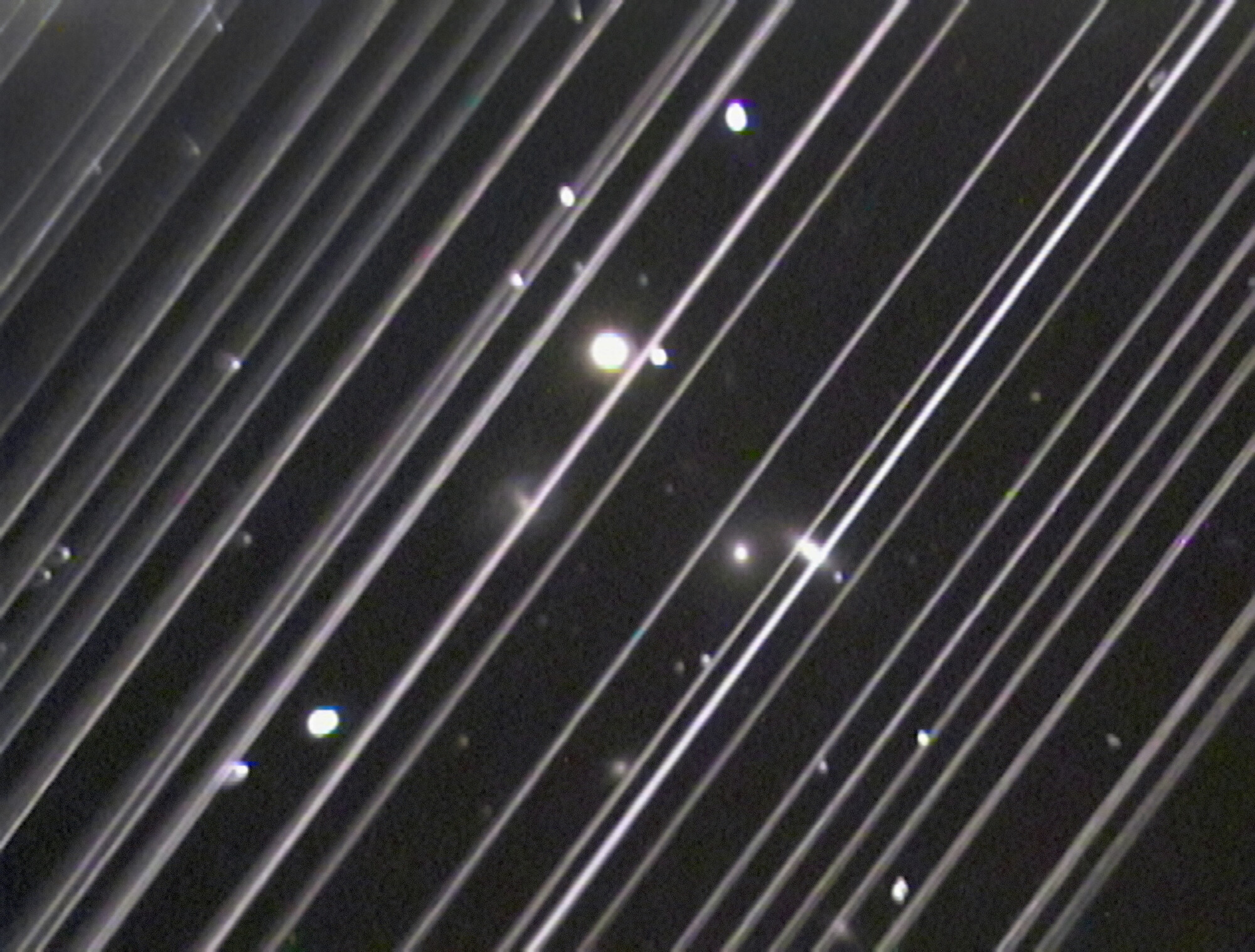Background
The Rapid Growth in the Space-based Internet Industry
Starlink Satellites over Carson National Forest, New Mexico, photographed soon after launch. Credit: Mike Lewinsky/Creative Commons Attribution.
Recent technological advances in ground stations, antennas, satellites and space launch capabilities, coupled with new telecommunications business models and a high demand for low-latency high-bandwidth internet, have driven rapid growth in the space-based internet industry (Daehnick et al., 2020). A number of companies are planning and now implementing communications constellations numbering hundreds to tens of thousands of satellites, particularly in commercial, non-geosynchronous low Earth orbit. In 2019 the Starlink constellation started the deployment of its first phase constellation, with a planned 4400 satellites located at an altitude of 550 kilometres, alongside OneWeb with a planned 680 satellites at 1200 kilometres. Following these first two constellations interest in this new type of constellation grew rapidly and filings to the International Telecommunication Union started to appear, including proposals ranging from thousands of satellites to several hundred of thousands.
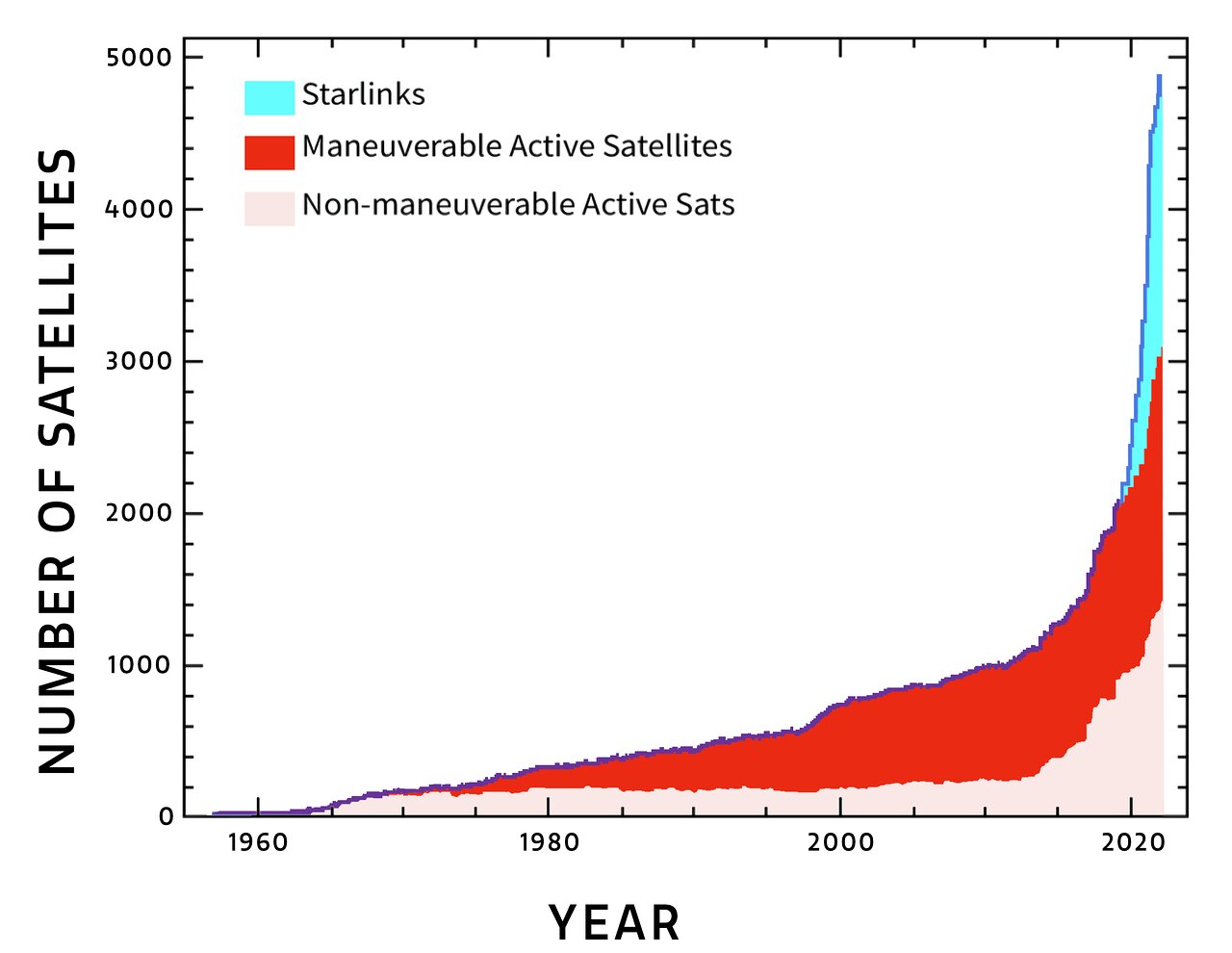
Plot of the number of satellites each year since 1957. The number of active satellites has more than doubled in the two years to May 2022; there were 2200 satellites in May 2020. Credit: J. McDowell/CFA
This rapid development in low Earth orbit satellites brought with it a variety of new challenges, including an increased probability of collisions, increased pollution of space in the form of space debris, increased complexity in tracking space objects, impacts on ground- and space-based astronomy, and even concerns about atmospheric pollution due to launch emissions and re-entry of satellite bodies.
While they may provide technological and societal benefits, satellite constellations are threatening to change the view of the night sky for almost everyone on the planet, given their large number and how satellites reflect sunlight and transmit in the radio. This change to the pristine night sky can impact dark sky reserves, astrophotography, religious and cultural practices, animal and insect life, and scientific inquiry. Astronomers have raised concerns about the impacts on scientific observations from the increasing probability of a sun-illuminated satellite’s passing through the field of view of a telescope, and also the growing numbers of space-based radio transmitting satellites within view of radio and millimetre-wave observatories. Many of these concerns have now been empirically validated with observations and simulations.
Initial studies indicate a variety of possible impacts from severe to minor for astronomy, depending on the nature of the telescope and satellite system (Walker et al., 2020; Hainaut & Williams, 2020; Ragazzoni, 2020; McDowell, 2020).
Effects on optical/infrared observations
This image of the galaxy group NGC 5353/4 was taken with a telescope at Lowell Observatory in Flagstaff, Arizona, on 25 May 2019. The diagonal lines are trails of reflected light left by more than 25 of the 60 Starlink satellites launched in May 2019, as they passed through the telescope’s field of view. When they leave their initial orbits, the satellites should diminish in brightness as they are boosted to a final orbital altitude. Credit: V. Girgis/ Lowell Observatory
The threats from the satellite constellations at optical wavelengths are quite significant and arise from three main factors: the apparent brightness of the satellites, the total number above the horizon at the locations of our observatories and the fraction of the night during which they are visible. A simulation of 10,000 spacecraft, as illustrated below, shows the number of satellites illuminated by the Sun at the latitude of Vera Rubin Observatory for constellations at 500 or 1000 kilometres altitude. The total number of satellite constellations may reach 4–20 times higher than this by the end of the decade.
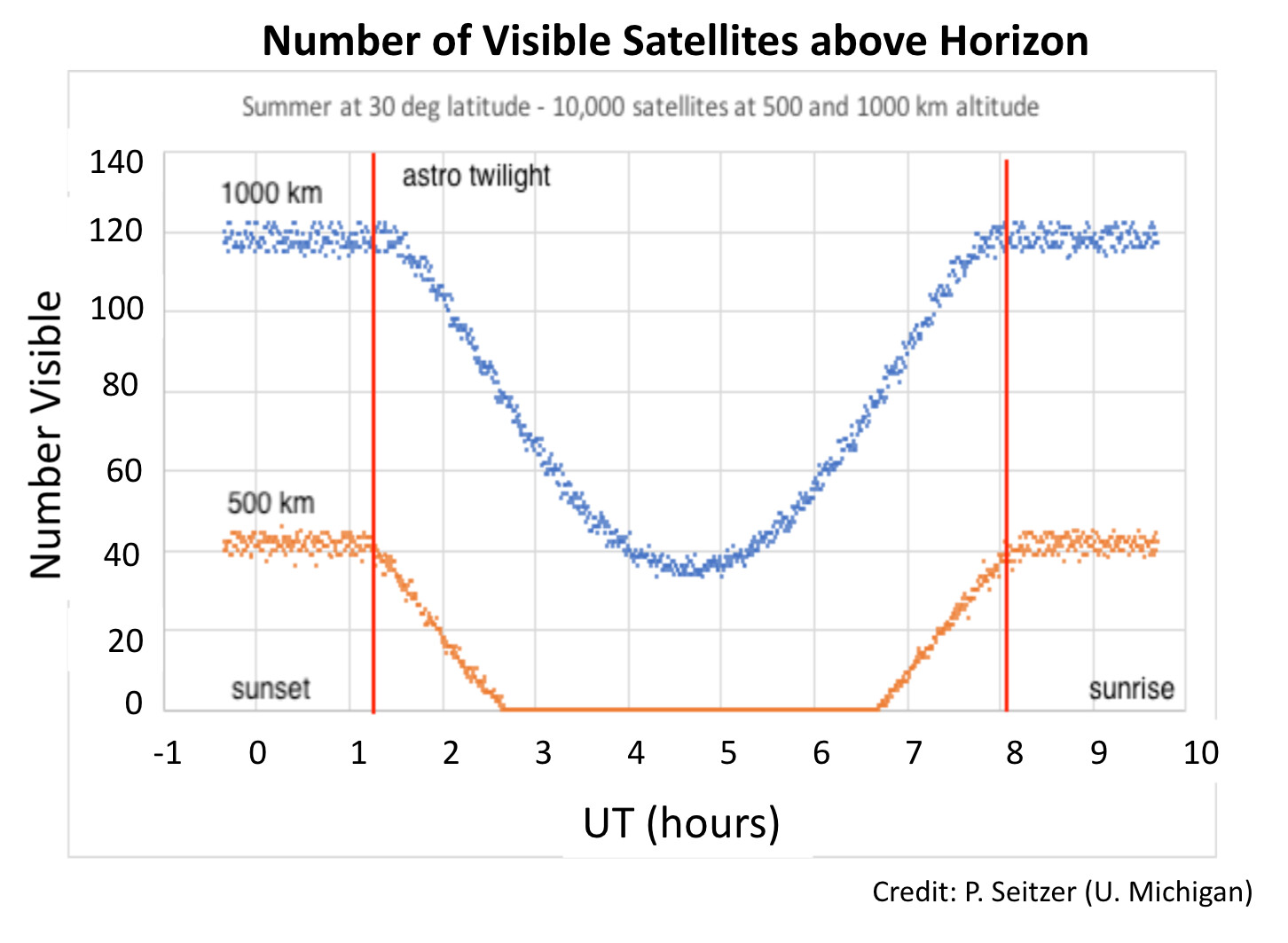
Simulation of 10,000 satellites at 1000 kilometres and at 500 kilometres altitude, at 30 degrees south latitude and 53 degrees inclination. The 10,000 satellites have 100 planes with 100 satellites each. Higher-altitude constellations (1200 kilometres) are very challenging to astronomy as they are visible all night long during the summer. Credit: P. Seitzer (U. Michigan)
At optical wavelengths, observations with long exposure times will be affected the most — particularly in the hours close to twilight and when observing low on the horizon, when sunlight hits them and they are not in Earth’s shadow. A prime example would be the Potentially Hazardous Asteroid research done by the International Asteroid Warning Network. The sunlit satellites can be confused with or mask asteroids coming toward Earth, some of which could impact Earth.
Observations with optical telescopes that observe large portions of the sky would also be affected. New-generation telescopes with wide fields of view and sensitive detectors, like Vera C. Rubin Observatory, coming online in the near future, will be significantly impacted if no substantial mitigations are implemented. Some mitigation measures include avoidance, but if there are hundreds of bright satellites (or more) in the sky at any given time, they will be impossible to avoid when observing. Some mitigation measures include software corrections which may remove some of the streaks in the images as a result of satellite constellations crossing through the telescope’s field of view. But data will be lost from where the streaks are removed, and contamination in data products where streaks were not accurately identified or removed.
While optical telescopes with narrow fields of view are less impacted, since the probability that satellites will cross the field of view is lower, observations with long exposure times and particularly in the hours close to twilight and low on the horizon will be affected.
Effects on radio observations
The situation for radio astronomy is somewhat different, given the experience of the radio astronomy community in dealing with satellites through spectrum management. Nevertheless, the spectacular increase in satellite numbers has escalated this problem to the extent that it not only endangers the radio astronomy protected bands (as a result of adjacent and spurious transmissions) but also increases the probability of saturating wideband receivers and hinders the ability of radio telescopes to observe other parts of the spectrum needed for many scientific cases. Wide-band continuum observations, redshifted spectroscopy, transients, and Very Long Baseline Interferometry for the purposes of geodesy are amongst the affected cases.
As a radio telescope is sensitive to signals arriving from any direction in the sky (through its main beam or sidelobes), the prospect of hundreds of satellites above the horizon at any moment in time and moving at high speeds will require updates to the theory and techniques used to mitigate satellite interference. As an illustration of the drastic change in the situation, the figure below illustrates the movement of geosynchronous satellites in the local sky compared with two of the most advanced satellite constellations.
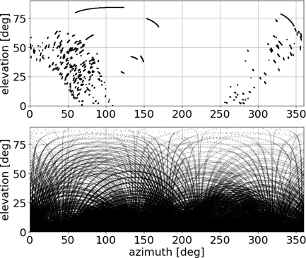
Movement of satellites above the horizon as seen from the SKA-Mid site in South Africa. The top panel shows all the currently active geosynchronous satellites for a period of 2000 seconds, and the bottom panel shows the movement of OneWeb and Starlink phase 1 over the same duration. Credit: F. Di Vruno (SKAO).
The first series of workshop/conferences
The goal of the SATCON1 workshop was to identify issues and recommended mitigations of the impact of satellite constellations on astronomy. NSF's NOIRLab and the American Astronomical Society (AAS) organised this conference which took place as an online workshop with more than 220 attendees from 29 June to 2 July 2020.
The Dark and Quiet Skies I conference was held online from 5 to 9 October 2020, with more than 970 registered participants. Each daily session was followed by between 250 to 380 online attendees. Dark and Quiet Skies I was co-organised by UNOOSA, the IAU and Spain, with support from NSF’s NOIRLab. A draft report, prepared during the preceding months by internationally recognised experts, was made available to the registered participants prior to the event. All participants were then invited to submit written comments within one week of the conclusion of the conference. Their comments were then used to finalise the Conference Report. The report represents the most up-to-date and authoritative analysis of the impact on astronomy by three classes of interference: artificial light at night, the large number of low-Earth-orbit satellite trails, and radio-wavelength emission.
The second series of workshops/conferences
The primary goal of the online SATCON2 workshop, held 12–16 July 2021, was to develop specific, implementable paths to carrying out the recommendations from SATCON1. Over 550 people registered for the SATCON2 workshop. The workshop’s two additional goals were to engage a considerably wider group of stakeholders in the conversations than had been presented at SATCON1 and to explore existing policy frameworks and present ideas for the development of policies capable of addressing an entirely new era in the exploration and use of space. In the couple of months before the workshop, four working groups prepared draft reports relevant to the workshop’s goals to present their findings at the workshop itself. Two of the working groups, Observations and Algorithms, explored some SATCON1 recommendations directly. The Community Engagement working group brought many new voices and perspectives to the issue, and the Policy working group examined regulatory framework and mitigation approaches from national, international, and industry viewpoints. The SATCON2 resulted in an Executive Report, as well as individual SATCON2 Working Group reports.
The Dark and Quiet Skies ll conference from 3 to 7 October 2021 focused on the technical and political actions needed to implement the recommendations from Dark and Quiet Skies I, in particular identifying which stakeholders and partners would need to collaborate to implement a satisfactory solution for the preservation of dark and quiet skies. Specifically, the topics concentrated on the impact of satellite constellations on astronomy and society, artificial light at night and radio astronomy. The conference was also co-organised by UNOOSA, the IAU and Spain, with support from NSF’s NOIRLab. It was to be hybrid, but an erupting volcano on the Canary Island of La Palma caused the conference to be moved entirely online, so as to not use resources needed on the island for its inhabitants. The conference programme included invited talks and contributions selected through a call for abstracts. A total of 724 individuals, 32 percent of whom were women, registered to attend the conference; 77 countries were represented. On average 140 people were attending at any one time. Results from the conference were presented at the UN COPUOS Science and Technology SubCommittee (STSC) meeting in February 2022. The Dark and Quiet Skies ll conference concluded with a comprehensive report.
In August 2022 a Focus Meeting (FM 2 — Towards a World Standard for Dark and Quiet Sky Protection) at the IAU General Assembly in Busan, South Korea will be dedicating its second day (9 August 2022) to presentations and discussion on the impact of satellite constellations on astronomy and mitigation solutions. In October 2023 an IAU Symposium (IAUS 385 — Astronomy and Satellite Constellations: Pathways Forward) is planned on the island of La Palma in the Canary Islands, which will include a progress report from the CPS.
The IAU actions as permanent observer in the COPUOS
Both a Conference Room Paper (CRP) and a Technical Presentation were presented to the 58th meeting of the UN Committee on the Peaceful Use of Outer Space’s (COPUOS) STSC on 21 April 2021. Six countries joined the authorship of the CRP before the meeting and delegates from another dozen countries supported the recommendations made within the CRP during the meeting. The outcomes of the Dark & Quiet Skies Conference were presented to the Scientific and Technical subcommittee, notably recommending measures to mitigate the impact of satellite constellations on astronomy. As a result, in August CPS management was invited to report at the full COPUOS meeting, a body in charge of governing the exploration and use of space for the benefit of all humanity, to which both the IAU and the SKAO have the status of Permanent Observer.
A presentation was made to the delegates attending the hybrid UN COPUOS in August 2021 to request a single agenda item for the February 2022 STSC meeting, dedicated to the topic of the impact of satellite constellations on astronomy and society. Consensus was not reached and the request was revisited at the in-person UN COPUOS Science and Technology Sub-Committee meeting in February 2022, where a single agenda item was granted. CPS management was also asked to present at the STSC symposium on Dark and Quiet Skies at that time.
The STSC, at its 59th meeting, on 7 February 2022, agreed to include an item entitled “General exchange of views on dark and quiet skies for science and society”, as a single issue/item for discussion on the agenda. The representatives of Algeria, Australia, Austria, Chile, the Czech Republic, France, Germany, Indonesia, Italy, the Russian Federation, South Africa, Spain, Turkey, the United Kingdom and the United States made statements under this item (item 18). The observers from the IAU and the SKAO also made statements under the item. During the general exchange of views, statements relating to item 18 were also made by representatives of other member States. The Subcommittee had before it the following: (a) Report on the United Nations/Spain/International Astronomical Union Conference on Dark and Quiet Skies for Science and Society (A/AC.105/1255); (b) Note by the Secretariat containing a summary of discussions on dark and quiet skies for science and society (A/AC.105/1257); (c) Working paper entitled “Protection of dark and quiet skies”, prepared by Austria, Chile, the Dominican Republic, Slovakia, Spain, IAU, ESO and the Square Kilometre Array Observatory (A/AC.105/C.1/L.396).
In addition, several IAU Commission B7 members (and Dark and Quiet Skies Protection Executive Working Group members and Dark and Quiet Skies Working Group members) presented at the STSC Industry Symposium at the STSC meeting. The two-hour Industry Symposium focuses annually on one theme only and this year it was on the impact of satellite constellations on astronomy and the mitigations possible. The symposium was a major opportunity to inform the UN Delegates and to “go on the record”. Emphasis was placed on the growing partnership between the astronomy community and industry in achieving feasible solutions.
Contact
Share your feedback and content
